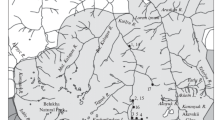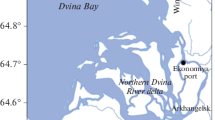Abstract
The impact of trace elements from the Iron Mountain Superfund site on the Sacramento River and selected tributaries is examined. The concentration and distribution of many trace elements—including aluminum, arsenic, boron, barium, beryllium, bismuth, cadmium, cerium, cobalt, chromium, cesium, copper, dysprosium, erbium, europium, iron, gadolinium, holmium, potassium, lanthanum, lithium, lutetium, manganese, molybdenum, neodymium, nickel, lead, praseodymium, rubidium, rhenium, antimony, selenium, samarium, strontium, terbium, thallium, thulium, uranium, vanadium, tungsten, yttrium, ytterbium, zinc, and zirconium—were measured using a combination of inductively coupled plasma-mass spectrometry and inductively coupled plasma-atomic emission spectrometry. Samples were collected using ultraclean techniques at selected sites in tributaries and the Sacramento River from below Shasta Dam to Freeport, California, at six separate time periods from mid-1996 to mid-1997. Trace-element concentrations in dissolved (ultrafiltered [0.005-μm pore size]) and colloidal material, isolated at each site from large volume samples, are reported. For example, dissolved Zn ranged from 900 μg/L at Spring Creek (Iron Mountain acid mine drainage into Keswick Reservoir) to 0.65 μg/L at the Freeport site on the Sacramento River. Zn associated with colloidal material ranged from 4.3 μg/L (colloid-equivalent concentration) in Spring Creek to 21.8 μg/L at the Colusa site on the Sacramento River. Virtually all of the trace elements exist in Spring Creek in the dissolved form. On entering Keswick Reservoir, the metals are at least partially converted by precipitation or adsorption to the particulate phase. Despite this observation, few of the elements are removed by settling; instead the majority is transported, associated with colloids, downriver, at least to the Bend Bridge site, which is 67 km from Keswick Dam. Most trace elements are strongly associated with the colloid phase going downriver under both low- and high-flow conditions.






Similar content being viewed by others
References
Alpers CN, Taylor HE, Domagalski JL (eds) (2000a) Metal transport in the Sacramento River, California, 1996-1997. Volume 1. Methods and data. United States Geological Survey Water–Resources Investigations Report 99-4286. http://pubs.usgs.gov/wri/wrir_994286/wrir994286.pdf. Accessed 12 December 2011
Alpers CN, Antweiler RC, Taylor HE, Dileanis PD, Domalgalski JL (2000b) Metal transport in the Sacramento River, California, 1996-97. Volume 2: Interpretation of metal loads. United States Geological Survey Water–Resources Investigations Report 00-4002. http://pubs.usgs.gov/wri/wrir00-4002/vol2.book.pdf. Accessed 12 December 2011
Antweiler RC, Taylor HE (1998) A pseudo-flow injection system for the analysis of major and trace metals by axial ICP-AES. In: Proceedings of the 40th Rocky Mountain Conference on Analytical Chemistry, Denver
Antweiler RC, Dileanis, PD Alpers CN, Taylor HE, Domagalski JL (2000) Study design: Field and laboratory methods: In: Alpers CN, Taylor HE, Domagalski JL (eds) Results: Part 1. Methods and results. United States Geological Survey Water-Resources Investigations Report 99-4286
Aruga R, Gastaldi D, Negro G, Ostacoli G (1995) Pollution of a river basin and its evolution with time studied by multivariate statistical analysis. Anal Chim Acta 3:15–25
Benoit G (1995) Evidence of the particle concentration effect for lead and other metals in fresh waters based on ultraclean technique analysis. Geochim Cosmochim Acta 59:2677–2687
Coale KH, Flegal AR (1989) Copper, zinc, cadmium and lead in surface waters of Lake Erie and Ontario. Sci Total Environ 87(88):297–304
Davis A, Olsen RL, Walker DR (1991) Distribution of metals between water and entrained sediment in streams impacted by acid mine discharge, Clear Creek, Colorado, U.S.A. Appl Geochem 6:333–348
Droppo IG, Jaskot C (1995) Impact of river transport characteristics on contaminant sampling error and design. Environ Sci Technol 29:161–170
Gaillardet J, Viers J, Dupre B (2003) Trace elements in river waters. In: Dreaver JI, Holland HD, Turekian KK (eds) Treatise on geochemistry. Surface and groundwater weathering and soils, vol 5. Elsevier-Pergamon, Oxford, pp 225–272
Garbarino JR, Taylor HE (1979) An inductively coupled plasma atomic-emission spectrometric method for routine water quality testing. Appl Spectrosc 33:220–226
Garbarino JR, Taylor HE (1995) Inductively coupled plasma-mass spectrometric method for the determination of dissolved trace elements in natural water. United States Geological Survey Water-Resources Investigations Report 94-358
Goldstein SJ, Jacobsen SB (1998) Rare earth elements in river waters. Earth Plan Sci Lett 89:35–47
Hirsch RM, Alley WM, Wilber WG (1988) Concepts for a national water-quality assessment program: United States Geological Survey Circular 1021
Ingri J, Widerlund A (1994) Uptake of alkali and alkaline-earth elements on suspended iron and manganese in the Kalix River, northern Sweden. Geochim Cosmochim Acta 58:5433–5442
Ingri J, Widerlund A, Land M, Gustafsson O, Andersson P, Ohlander B (2000) Temporal variations in the fractionation of rare earth elements in a boreal river: the role of colloid particles. Chem Geol 166:23–45
Kelly T, Taylor HE (1996) Concentrations and loads of specific trace elements and other selected constituents in the Rio Grande, Albuquerque area, New Mexico. United States Geological Survey Water-Resources Investigations Report 96-126
Kimball BA, Callender E, Axtmann EV (1995) Effects of colloids on metal transport in a river receiving acid mine drainage, upper Arkansas River, Colorado, USA. Appl Geochem 10:285–306
Lammers WT (1968) Fractionation of suspended and colloidal particles in natural water. Report No. K-1749. Union Carbide Corporation, Oak Ridge
Leenheer JA, Meade RH, Taylor HE, Pereira WE (1989) Sampling, fractionation, and dewatering of suspended sediment from the Mississippi River for geochemical and trace contaminant analysis. In: Mallard GE (ed) United States Geological Survey Toxic Substances Hydrology Program: Proceedings of the technical meeting, Phoenix, AZ, Sept. 26–30, 1988. United States Geological Survey Water–Resources Investigations Report 88-4220, pp 501–511
McCleskey RB, Nordstrom DK, Susong DD, Ball JW, Taylor HE (2010) Source and fate of inorganic solutes in the Gibbon River, Yellowstone National Park, Wyoming. J Vol Geotherm Res 10:1016
Millipore Corporation (1998) Selecting a membrane for concentration, desalting and buffer exchange of macromolecules (ultrafiltration). Millipore, Bedford
Montoya B, Blatt F, Harris GA (1988) Mass loading assessment of major point and non-point sources discharging to surface waters in the Central Valley, California, 1985. Standards, policies and special studies section. Central Valley Regional Water Quality Control Board staff report
Morel FMM, Gschwend PM (1987) The role of colloids in the partitioning of solutes in natural waters. In: Stumm W (ed) Aquatic surface chemistry. Wiley, New York, pp 405–422
Peart DB, Antweiler RA, Taylor HE, Roth DA, Brinton TI (1998) A re-evaluation and extension of the scope of United States Geological Survey Standard Reference samples. Analyst 3:455
Roth DA, Taylor HE, Domalgalski J, Dileanis P, Peart DB, Antweiler RC et al (2001) Distribution of inorganic mercury in Sacramento River water and suspended colloidal sediment material. Arch Environ Contam Toxicol 40:161–172
Rousseeuw PJ (1990) Robust estimation and identifying outliers. In: Wadsworth HM (ed) Handbook of statistical methods for engineers and scientists. McGraw Hill, New York, pp 16–24
Shiller AM (2002) Seasonality of dissolved rare earth elements in the lower Mississippi River. Geochem Geophys Geosys 3(11):1068
Shiller AM, Boyle EA (1985) Dissolved zinc in rivers. Nature 317:49–52
Shiller AM, Boyle EA (1987) Variability of dissolved trace metals in the Mississippi River. Geochim Cosmochim Acta 51:3273–3277
Shiller AM, Taylor HE (1996) Problems associated with using filtration to define dissolved trace element concentrations in natural waters. Environ Sci Technol 30:3397–3398
Shiller AM, Chen Z, Hannigan R (2001) A time series of dissolved rare earth elements in the lower Mississippi River. In: Cidu R (ed) Water-rock interaction. Swets & Zeitlinger, Lisse, pp 1005–1007
Sholkovitz ER (1995) The aquatic chemistry of rare earth elements in rivers and estuaries. Aquat Geochem 1:1–34
Smith KS, Ficklin WH, Plumlee GS, Meier AL (1992) Metal and arsenic partitioning between water and suspended sediment at mine-drainage sites in diverse geologic settings. In: Kharaka YK, Maest AS (eds) Water-rock interaction. Balkema, Rotterdam, pp 443–447
Stroh A (1992) Analysis of rare earth elements in natural waters by ICP-MS. Spectroscopy 13:89–92
Taylor HE (2001) Inductively coupled plasma-mass spectrometry: practices and techniques. Academic Press, San Diego
Taylor HE, Garbarino JR (1991) The measurement of trace metals in water resource monitoring samples by inductively coupled plasma-mass spectrometry. Spectrochim Acta Rev 14:33–43
Taylor HE, Shiller AM (1995) Mississippi River methods comparison study—implications for water-quality monitoring of dissolved trace elements. Environ Sci Technol 29:1313–1317
Taylor HE, Garbarino JR, Brinton TI (1990) The occurrence and distribution of trace metals in the Mississippi River and its tributaries. Sci Total Environ 97/98:369–384
Taylor HE, Shiller AM, Garbarino JR, Brinton TI (1995) Intercomparison experiments on dissolved trace-metal data from the Mississippi River and some of its tributaries: United States Geological Survey Water-Resources Investigations Report 93-628
Taylor HE, Antweiler RC, Alpers CN, Roth DA, Brinton TI, Cain DJ (2000) Quality assurance and quality control. In: Alpers CN, Taylor HE, Domagalski JL (eds) Metal transport in the Sacramento River, California, 1996-97. Part 1. Methods and results. United States Geological Survey Water-Resources Investigations Report 99-4286, pp 38–59
Taylor HE, Antweiler RC, Roth DA, Brinton TI, Peart DB, Healy DF (2001) The occurrence and distribution of selected trace elements in the upper Rio Grande and tributaries in Colorado and northern New Mexico. Arch Environ Contam Toxicol 41:410–426
Tricca A, Stille P, Steinmann M, Kiefel B, Samuel J, Eikenberg J (1999) Rare earth elements and Sr and Nd isotopic compositions of dissolved and suspended loads from small river systems in the Vosges mountains (France), the river Rhine and groundwater. Chem Geol 160:139–158
Webb WE, Radtke DB, Iwatsubo RT (1999) Surface water sampling: Collection methods at flowing-water and still-water sites: In: National field manual for the collection of water quality data. Book 9, chap A4, United States Geological Survey Techniques of Water-Resources Investigations, pp 23–89
Windom HL, Byrd JT, Smith RG Jr, Huan F (1991) Inadequacy of NASQAN data for assessing metal trends in the nation’s rivers. Environ Sci Technol 25:1137–1142
Acknowledgments
The authors acknowledge the contributions of Joseph Domalgalski, Michael Hunerlach, Dale Peart, and Terry Plowman. We also thank Susan Riggins and James Crock for their review of an earlier version of this manuscript. The use of trade names is for identification purposes only and does not imply endorsement by the United States Geological Survey.
Author information
Authors and Affiliations
Corresponding author
Rights and permissions
About this article
Cite this article
Taylor, H.E., Antweiler, R.C., Roth, D.A. et al. Selected Trace Elements in the Sacramento River, California: Occurrence and Distribution. Arch Environ Contam Toxicol 62, 557–569 (2012). https://doi.org/10.1007/s00244-011-9738-z
Received:
Accepted:
Published:
Issue Date:
DOI: https://doi.org/10.1007/s00244-011-9738-z




